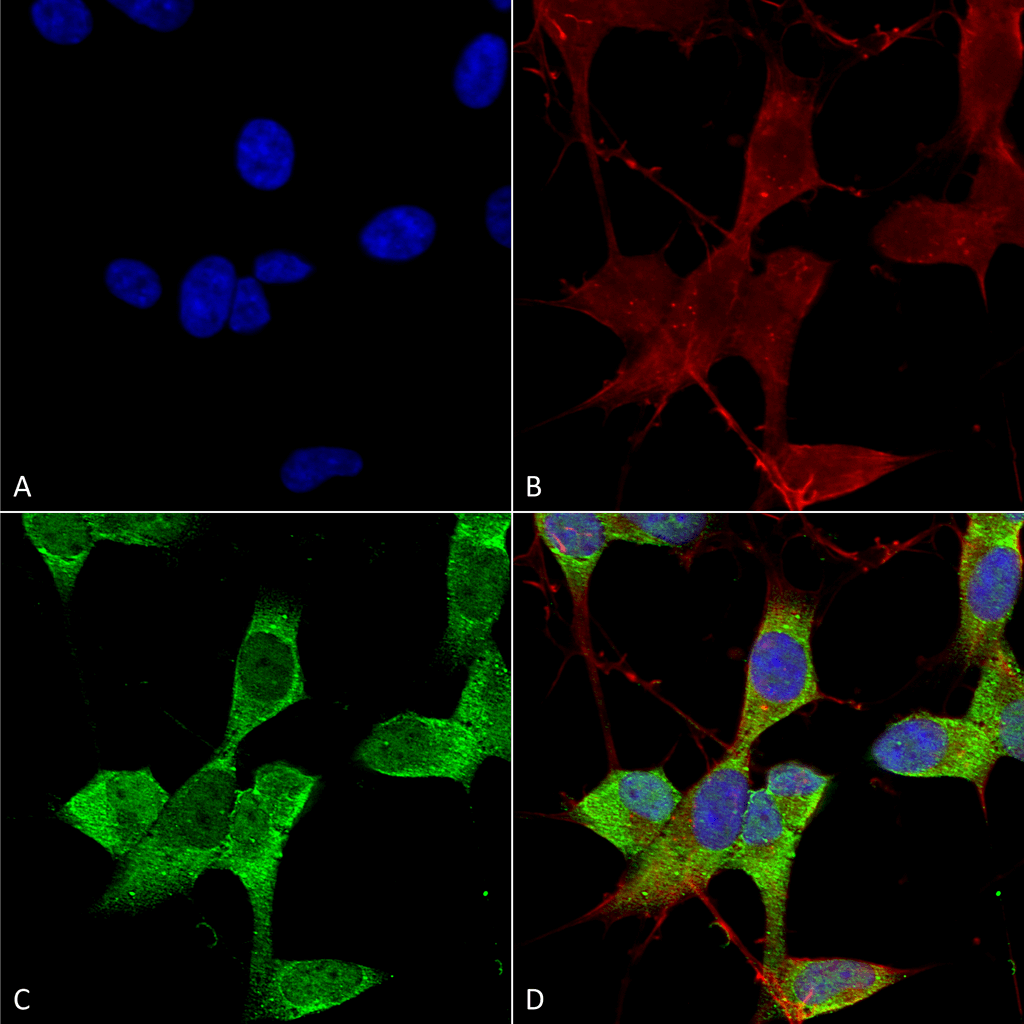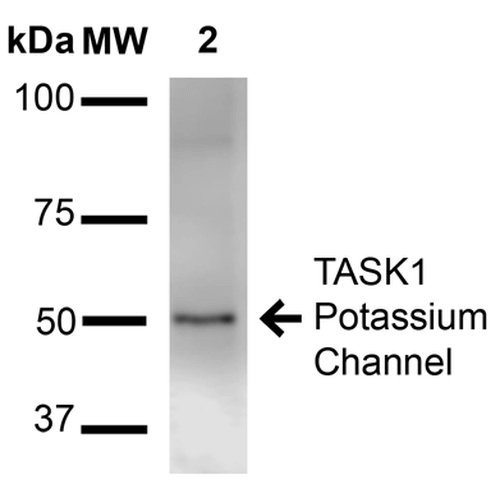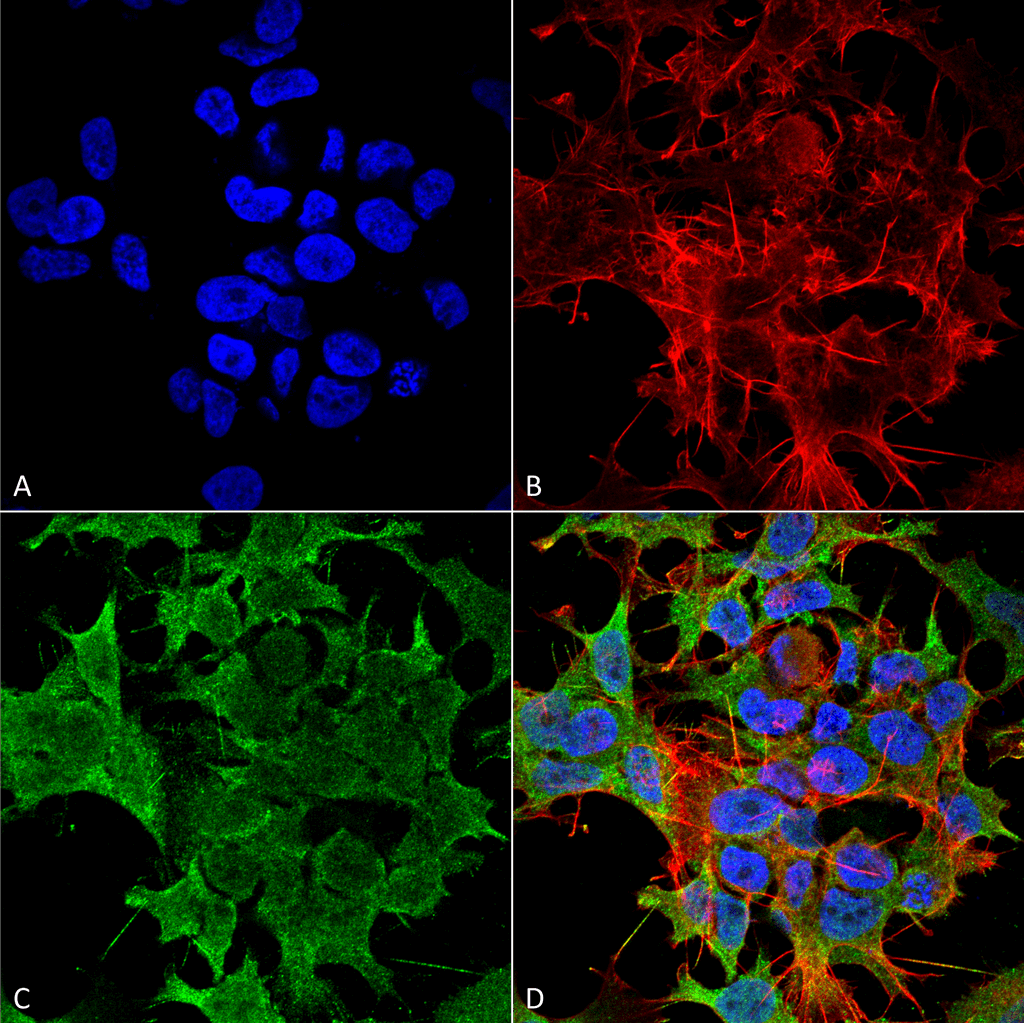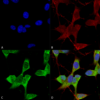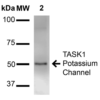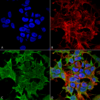Anti-TASK1 Potassium Channel Antibody (11578)
$466.00
| Host | Quantity | Applications | Species Reactivity | Data Sheet | |
|---|---|---|---|---|---|
| Mouse | 100ug | WB,IHC,ICC/IF | Human, Mouse, Rat |  |
SKU: 11578
Categories: Antibody Products, Ion Channel Antibodies
Overview
Product Name Anti-TASK1 Potassium Channel Antibody (11578)
Description Anti-TASK1 Potassium Channel Mouse Monoclonal Antibody
Target TASK1 Potassium Channel
Species Reactivity Human, Mouse, Rat
Applications WB,IHC,ICC/IF
Host Mouse
Clonality Monoclonal
Clone ID S374-48
Isotype IgG2b
Immunogen Fusion protein corresponding to aa 251-411 (cytoplasmic C-terminus) of rat TASK1. This sequence is 96
Properties
Form Liquid
Concentration 1.0 mg/mL
Formulation PBS, pH 7.4, 0.1% sodium azide, 50% glycerol.
Buffer Formulation Phosphate Buffered Saline
Buffer pH pH 7.4
Buffer Anti-Microbial 0.1% Sodium Azide
Buffer Cryopreservative 50% Glycerol
Format Purified
Purification Purified by Protein G affinity chromatography
Specificity Information
Specificity This antibody recognizes human, mouse, and rat TASK1.
Target Name Potassium channel subfamily K member 3
Target ID TASK1 Potassium Channel
Uniprot ID O54912
Alternative Names Acid-sensitive potassium channel protein TASK-1, TWIK-related acid-sensitive K(+ channel 1, Two pore potassium channel KT3.1, Two pore K(+ channel KT3.1
Gene Name Kcnk3
Accession Number NP_203694.1
Sequence Location Cell membrane, Multi-pass membrane protein
Biological Function pH-dependent, voltage-insensitive, background potassium channel protein. Rectification direction results from potassium ion concentration on either side of the membrane. Acts as an outward rectifier when external potassium concentration is low. When external potassium concentration is high, current is inward. {UniProtKB:O14649}.
Research Areas Ion Channels
Background TASK1 channels are members of the two-pore domain family of potassium channels whose structure consists of two pore-forming regions flanked by four membrane-spanning domains. The activity of these channels is sensitive to changes in extracellular pH in the physiological range. Like other two-pore domain family members, these channels show little time or voltage dependence. Thus they have characteristics of leak K+ channels, generating background currents that contribute to membrane potential and the shaping of cell excitability.
Application Images




Description Immunocytochemistry/Immunofluorescence analysis using Mouse Anti-TASK1 Potassium Channel Monoclonal Antibody, Clone S374-48 (11578). Tissue: Neuroblastoma cells (SH-SY5Y). Species: Human. Fixation: 4% PFA for 15 min. Primary Antibody: Mouse Anti-TASK1 Potassium Channel Monoclonal Antibody (11578) at 1:50 for overnight at 4°C with slow rocking. Secondary Antibody: AlexaFluor 488 at 1:1000 for 1 hour at RT. Counterstain: Phalloidin-iFluor 647 (red) F-Actin stain; Hoechst (blue) nuclear stain at 1:800, 1.6mM for 20 min at RT. (A) Hoechst (blue) nuclear stain. (B) Phalloidin-iFluor 647 (red) F-Actin stain. (C) TASK1 Potassium Channel Antibody (D) Composite.

Description Western Blot analysis of Rat Brain Membrane showing detection of ~50 kDa TASK1 Potassium Channel protein using Mouse Anti-TASK1 Potassium Channel Monoclonal Antibody, Clone S374-48 (11578). Lane 1: Molecular Weight Ladder (MW). Lane 2: Rat brain membrane. Load: 15 µg. Block: 2% BSA and 2% Skim Milk in 1X TBST. Primary Antibody: Mouse Anti-TASK1 Potassium Channel Monoclonal Antibody (11578) at 1:1000 for 16 hours at 4°C. Secondary Antibody: Goat Anti-Mouse IgG: HRP at 1:2000 for 60 min at RT. Color Development: ECL solution for 6 min at RT. Predicted/Observed Size: ~50 kDa.

Description Immunocytochemistry/Immunofluorescence analysis using Mouse Anti-TASK1 Potassium Channel Monoclonal Antibody, Clone S374-48 (11578). Tissue: Neuroblastoma cell line (SK-N-BE). Species: Human. Fixation: 4% Formaldehyde for 15 min at RT. Primary Antibody: Mouse Anti-TASK1 Potassium Channel Monoclonal Antibody (11578) at 1:100 for 60 min at RT. Secondary Antibody: Goat Anti-Mouse ATTO 488 at 1:100 for 60 min at RT. Counterstain: Phalloidin Texas Red F-Actin stain; DAPI (blue) nuclear stain at 1:1000, 1:5000 for 60min RT, 5min RT. Localization: Membrane. Magnification: 60X. (A) DAPI (blue) nuclear stain. (B) Phalloidin Texas Red F-Actin stain. (C) TASK1 Potassium Channel Antibody. (D) Composite.
Handling
Storage This product is stable for at least one (1) year at -20°C.
Dilution Instructions Dilute in PBS or medium that is identical to that used in the assay system.
Application Instructions Immunoblotting: use at 1-5ug/mL. A band of ~50kDa is detected.
Immunofluorescence: use at 10ug/mL.
These are recommended concentrations.
Endusers should determine optimal concentrations for their application.
Immunofluorescence: use at 10ug/mL.
These are recommended concentrations.
Endusers should determine optimal concentrations for their application.
References & Data Sheet
Data Sheet  Download PDF Data Sheet
Download PDF Data Sheet
 Download PDF Data Sheet
Download PDF Data Sheet

